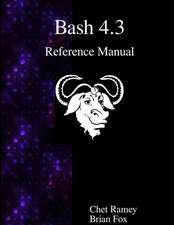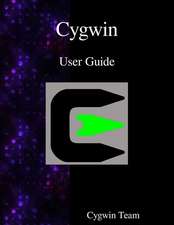Advanced Programming in the Unix Environment: A Companion for ScrumMasters, Agile Coaches, and Project Managers in Transition: Addison-Wesley Professional Computing
Autor Stephen A. Rago, W. Richard Stevensen Limba Engleză Paperback – 13 mai 2013
The new third edition of Advanced Programming in the UNIX® Environment supports today's leading platforms, reflects new technical advances and best practices, and aligns with Version 4 of the Single UNIX Specification. This valuable tool begins with files, directories, and processes, carefully laying the groundwork for more advanced techniques, such as signal handling and terminal I/O then thoroughly covers threads and multithreaded programming, and socket-based IPC. This edition covers more than seventy new interfaces, including POSIX asynchronous I/O, spin locks, barriers, and POSIX semaphores. Students are given examples, including more than ten thousand lines of downloadable, ISO C source code. More than four hundred system calls and functions are demonstrated with concise, complete programs that clearly illustrate their usage, arguments, and return values. To tie together what they've learned, the book presents several chapter-length case studies, each reflecting contemporary environments.
Preț: 355.30 lei
Preț vechi: 444.12 lei
-20% Nou
67.98€ • 70.99$ • 56.14£
Carte disponibilă
Livrare economică 25 martie-08 aprilie
Livrare express 11-15 martie pentru 79.86 lei
Specificații
ISBN-10: 0321637739
Pagini: 1024
Ilustrații: Illustrations
Dimensiuni: 188 x 231 x 51 mm
Greutate: 1.76 kg
Ediția:Revised
Editura: Addison-Wesley Professional
Seria Addison-Wesley Professional Computing
Notă biografică
Cuprins
Foreword to the Second Edition xix
Preface xxi
Preface to the Second Edition xxv
Preface to the First Edition xxix
Chapter 1: UNIX System Overview 1
1.1 Introduction 11.2 UNIX Architecture 1
1.3 Logging In 2
1.4 Files and Directories 4
1.5 Input and Output 8
1.6 Programs and Processes 10
1.7 Error Handling 14
1.8 User Identification 16
1.9 Signals 18
1.10 Time Values 20
1.11 System Calls and Librar y Functions 21
1.12 Summary 23
Chapter 2: UNIX Standardization and Implementations 25
2.1 Introduction 252.2 UNIX Standardization 25
2.3 UNIX System Implementations 33
2.4 Relationship of Standards and Implementations 36
2.5 Limits 36
2.6 Options 53
2.7 Feature Test Macros 57
2.8 Primitive System Data Types 58
2.9 Differences Between Standards 58
2.10 Summary 60
Chapter 3: File I/O 61
3.1 Introduction 613.2 File Descr iptors 61
3.3 open and openat Functions 62
3.4 creat Function 66
3.5 close Function 66
3.6 lseek Function 66
3.7 read Function 71
3.8 write Function 72
3.9 I/O Efficiency 72
3.10 File Shar ing 74
3.11 Atomic Operations 77
3.12 dup and dup2 Functions 79
3.13 sync, fsync, and fdatasync Functions 81
3.14 fcntl Function 82
3.15 ioctl Function 87
3.16 /dev/fd 88
3.17 Summary 90
Chapter 4: Files and Directories 93
4.1 Introduction 934.2 stat, fstat, fstatat, and lstat Functions 93
4.3 File Types 95
4.4 Set-User-ID and Set-Group-ID 98
4.5 File Access Per missions 99
4.6 Ownership of New Files and Directories 101
4.7 access and faccessat Functions 102
4.8 umask Function 104
4.9 chmod, fchmod, and fchmodat Functions 106
4.10 Sticky Bit 108
4.11 chown, fchown, fchownat, and lchown Functions 109
4.12 File Size 111
4.13 File Tr uncation 112
4.14 File Systems 113
4.15 link, linkat, unlink, unlinkat, and remove Functions 116
4.16 rename and renameat Functions 119
4.17 Symbolic Links 120
4.18 Creating and Reading Symbolic Links 123
4.19 File Times 124
4.20 futimens, utimensat, and utimes Functions 126
4.21 mkdir, mkdirat, and rmdir Functions 129
4.22 Reading Director ies 130
4.23 chdir, fchdir, and getcwd Functions 135
4.24 Device Special Files 137
4.25 Summary of File Access Per mission Bits 140
4.26 Summary 140
Chapter 5: Standard I/O Library 143
5.1 Introduction 1435.2 Streams and FILE Objects 143
5.3 Standard Input, Standard Output, and Standard Error 145
5.4 Buffer ing 145
5.5 Opening a Stream 148
5.6 Reading and Writing a Stream 150
5.7 Line-at-a-Time I/O 152
5.8 Standard I/O Efficiency 153
5.9 Binary I/O 156
5.10 Positioning a Stream 157
5.11 For matted I/O 159
5.12 Implementation Details 164
5.13 Temporar y Files 167
5.14 Memory Streams 171
5.15 Alternatives to Standard I/O 174
5.16 Summary 175
Chapter 6: System Data Files and Information 177
6.1 Introduction 1776.2 Password File 177
6.3 Shadow Passwords 181
6.4 Group File 182
6.5 Supplementary Group IDs 183
6.6 Implementation Differences 184
6.7 Other Data Files 185
6.8 Login Accounting 186
6.9 System Identification 187
6.10 Time and Date Routines 189
6.11 Summary 196
Chapter 7: Process Environment 197
7.1 Introduction 1977.2 main Function 197
7.3 Process Termination 198
7.4 Command-Line Arguments 203
7.5 Environment List 203
7.6 Memory Lay out of a C Program 204
7.7 Shared Librar ies 206
7.8 Memory Allocation 207
7.9 Environment Var iables 210
7.10 setjmp and longjmp Functions 213
7.11 getrlimit and setrlimit Functions 220
7.12 Summary 225
Chapter 8: Process Control 227
8.1 Introduction 2278.2 Process Identifiers 227
8.3 fork Function 229
8.4 vfork Function 234
8.5 exit Functions 236
8.6 wait and waitpid Functions 238
8.7 waitid Function 244
8.8 wait3 and wait4 Functions 245
8.9 Race Conditions 245
8.10 exec Functions 249
8.11 Changing User IDs and Group IDs 255
8.12 Interpreter Files 260
8.13 system Function 264
8.14 Process Accounting 269
8.15 User Identification 275
8.16 Process Scheduling 276
8.17 Process Times 280
8.18 Summary 282
Chapter 9: Process Relationships 285
9.1 Introduction 2859.2 Ter minal Logins 285
9.3 Networ k Logins 290
9.4 Process Groups 293
9.5 Sessions 295
9.6 Controlling Terminal 296
9.7 tcgetpgrp, tcsetpgrp, and tcgetsid Functions 298
9.8 Job Control 299
9.9 Shell Execution of Programs 303
9.10 Orphaned Process Groups 307
9.11 FreeBSD Implementation 310
9.12 Summary 312
Chapter 10: Signals 313
10.1 Introduction 31310.2 Signal Concepts 313
10.3 signal Function 323
10.4 Unreliable Signals 326
10.5 Interrupted System Calls 327
10.6 Reentrant Functions 330
10.7 SIGCLD Semantics 332
10.8 Reliable-Signal Ter minology and Semantics 335
10.9 kill and raise Functions 336
10.10 alarm and pause Functions 338
10.11 Signal Sets 344
10.12 sigprocmask Function 346
10.13 sigpending Function 347
10.14 sigaction Function 349
10.15 sigsetjmp and siglongjmp Functions 355
10.16 sigsuspend Function 359
10.17 abort Function 365
10.18 system Function 367
10.19 sleep, nanosleep, and clock_nanosleep Functions 373
10.20 sigqueue Function 376
10.21 Job-Control Signals 377
10.22 Signal Names and Numbers 379
10.23 Summary 381
Chapter 11: Threads 383
11.1 Introduction 38311.2 Thread Concepts 383
11.3 Thread Identification 384
11.4 Thread Creation 385
11.5 Thread Termination 388
11.6 Thread Synchronization 397
11.7 Summary 422
Chapter 12: Thread Control 425
12.1 Introduction 42512.2 Thread Limits 425
12.3 Thread Attr ibutes 426
12.4 Synchronization Attr ibutes 430
12.5 Reentrancy 442
12.6 Thread-Specific Data 446
12.7 Cancel Options 451
12.8 Threads and Signals 453
12.9 Threads and fork 457
12.10 Threads and I/O 461
12.11 Summary 462
Chapter 13: Daemon Processes 463
13.1 Introduction 46313.2 Daemon Character istics 463
13.3 Coding Rules 466
13.4 Error Logging 469
13.5 Single-Instance Daemons 473
13.6 Daemon Conventions 474
13.7 Client-Server Model 479
13.8 Summary 480
Chapter 14: Advanced I/O 481
14.1 Introduction 48114.2 Nonblocking I/O 481
14.3 Record Locking 485
14.4 I/O Multiplexing 500
14.5 Asynchronous I/O 509
14.6 readv and writev Functions 521
14.7 readn and writen Functions 523
14.8 Memory-Mapped I/O 525
14.9 Summary 531
Chapter 15: Interprocess Communication 533
15.1 Introduction 53315.2 Pipes 534
15.3 popen and pclose Functions 541
15.4 Coprocesses 548
15.5 FIFOs 552
15.6 XSI IPC 556
15.7 Message Queues 561
15.8 Semaphores 565
15.9 Shared Memor y 571
15.10 POSIX Semaphores 579
15.11 Client-Server Proper ties 585
15.12 Summary 587
Chapter 16: Network IPC: Sockets 589
16.1 Introduction 58916.2 Socket Descr iptors 590
16.3 Addressing 593
16.4 Connection Establishment 605
16.5 Data Tr ansfer 610
16.6 Socket Options 623
16.7 Out-of-Band Data 626
16.8 Nonblocking and Asynchronous I/O 627
16.9 Summary 628
Chapter 17: Advanced IPC 629
17.1 Introduction 62917.2 UNIX Domain Sockets 629
17.3 Unique Connections 635
17.4 Passing File Descriptors 642
17.5 An Open Server, Version 1 653
17.6 An Open Server, Version 2 659
17.7 Summary 669
Chapter 18: Terminal I/O 671
18.1 Introduction 67118.2 Over view 671
18.3 Special Input Characters 678
18.4 Getting and Setting Ter minal Attr ibutes 683
18.5 Ter minal Option Flags 683
18.6 stty Command 691
18.7 Baud Rate Functions 692
18.8 Line Control Functions 693
18.9 Ter minal Identification 694
18.10 Canonical Mode 700
18.11 Noncanonical Mode 703
18.12 Ter minal Window Size 710
18.13 termcap, terminfo, and curses 712
18.14 Summary 713
Chapter 19: Pseudo Terminals 715
19.1 Introduction 71519.2 Over view 715
19.3 Opening Pseudo-Ter minal Devices 722
19.4 pty_fork Function 726
19.5 pty Program 729
19.6 Using the pty Program 733
19.7 Advanced Features 740
19.8 Summary 741
Chapter 20: A Database Library 743
20.1 Introduction 74320.2 History 743
20.3 The Librar y 744
20.4 Implementation Over view 746
20.5 Centralized or Decentralized? 750
20.6 Concurrency 752
20.7 Building the Librar y 753
20.8 Source Code 753
20.9 Perfor mance 781
20.10 Summary 786
Chapter 21: Communicating with a Network Printer 789
21.1 Introduction 78921.2 The Inter net Pr inting Protocol 789
21.3 The Hyper text Transfer Protocol 792
21.4 Printer Spooling 793
21.5 Source Code 795
21.6 Summary 843
Appendix A: Function Prototypes 845
Appendix B: Miscellaneous Source Code 895
B.1 Our Header File 895
B.2 Standard Error Routines 898
Appendix C: Solutions to Selected Exercises 905
Bibliography 947
Index 955

























